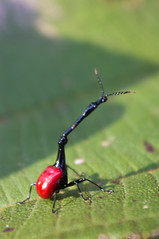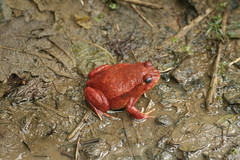It didn't get its name because it was as big as an elephant or because it had a large bill but because it was believed it could snatch up and carry off a baby elephant. From the skeletons found on the island, the elephant birds reached ten feet in height and close to a thousand pounds in weight. Like other large birds we know, such as ostriches and emus, the elephant bird was flightless. |
 |
a dwarf hippo by Jen McKenzie by Jen McKenzie |
There are reports that scientists may manipulate fragments of the DNA of the elephant bird, extracted from the eggshell, to resurrect it, a process called de-extinction.
 |
a giraffe beetle by ledgr by ledgr |
The oversized elephant bird is at one end of the size range of extinct animals. At the other end is the undersized dwarf hippo which also coexisted with humans for at least 1,000 years, perhaps longer. Dwarf hippos were not native to Madagascar. They probably migrated across the Mozambique channel from west Africa where another species of hippopotamus, the pygmy hippo, still exists, while the channel was shallow or while there were islands in the channel to help bridge the 225 miles that separate the island from the continent. But the dwarf hippo may have arrived in Madagascar as a normal-sized animal and grown smaller over time through insular dwarfism, a process of animals becoming smaller over successive generations when the area for foraging is small, such as on an island. The eyes of both the extinct dwarf hippo and the extant pygmy hippo of east Africa are on the sides of the animal's head instead of forward-facing on the top of the head as is the case for regular hippos.
In the 1990s, an anthropologist studying recent extinctions in Madagascar collected stories about an animal that had been seen in a west coast fishing village. Several villagers independently described the animal as recently as 1976 as resembling a hippopotamus that when frightened fled under water. No other animal in Madagascar fits that description, leading some to conclude that the dwarf hippo has only recently become extinct.
 |
fossa by csyork65 by csyork65 |
Madagascar has plenty of other unique wildlife including tiny frogs; insects including the long-necked giraffe beetles; geckos of all colors; chameleons; the lion-like fossa, the natural enemy of the lemur which is not in the cat family at all but rather is a relative of the monkey; and radiated tortoise. The inclusion of the fossa in the DreamWorks movie Madagascar was one touch that impressed me as it was entirely unnecessary for the story, but an accurate reference to Madagascar native animals. Since nearly all the large animals of Madagascar have all become extinct, and slash and burn agriculture has destroyed much of the natural habitat of the remaining animals, nearly all animal life in Madagascar needs protection.


That is very interesting
ReplyDelete